Health Care Organizational Structure and Culture at Road Living Scheme
VerifiedAdded on 2021/11/03
|11
|2204
|122
Report
AI Summary
This report examines the organizational culture and structure of Road Living Scheme, a supported living scheme for homeless veterans with health challenges. It explores the organization's functional structure and clan culture, highlighting the roles of mentorship and a family-like environment. The report analyzes the impact of the organizational structure on its culture, specifically how the functional and hierarchical designs affect communication and power distribution. It recommends a shift towards a flatarchy structure to improve communication and collaboration, along with the implementation of an enterprise system for enhanced efficiency in operations and record management. The report emphasizes the importance of considering the needs of employees and aligning leadership approaches with the organizational culture to improve performance and growth.

Running head: Health Care Organizational Structure and Culture 1
Analyzing the Impacts of Organizational Structure on its Culture
Name of Student
Name of Institution
Name of Course
Date of Submission
Analyzing the Impacts of Organizational Structure on its Culture
Name of Student
Name of Institution
Name of Course
Date of Submission
Paraphrase This Document
Need a fresh take? Get an instant paraphrase of this document with our AI Paraphraser
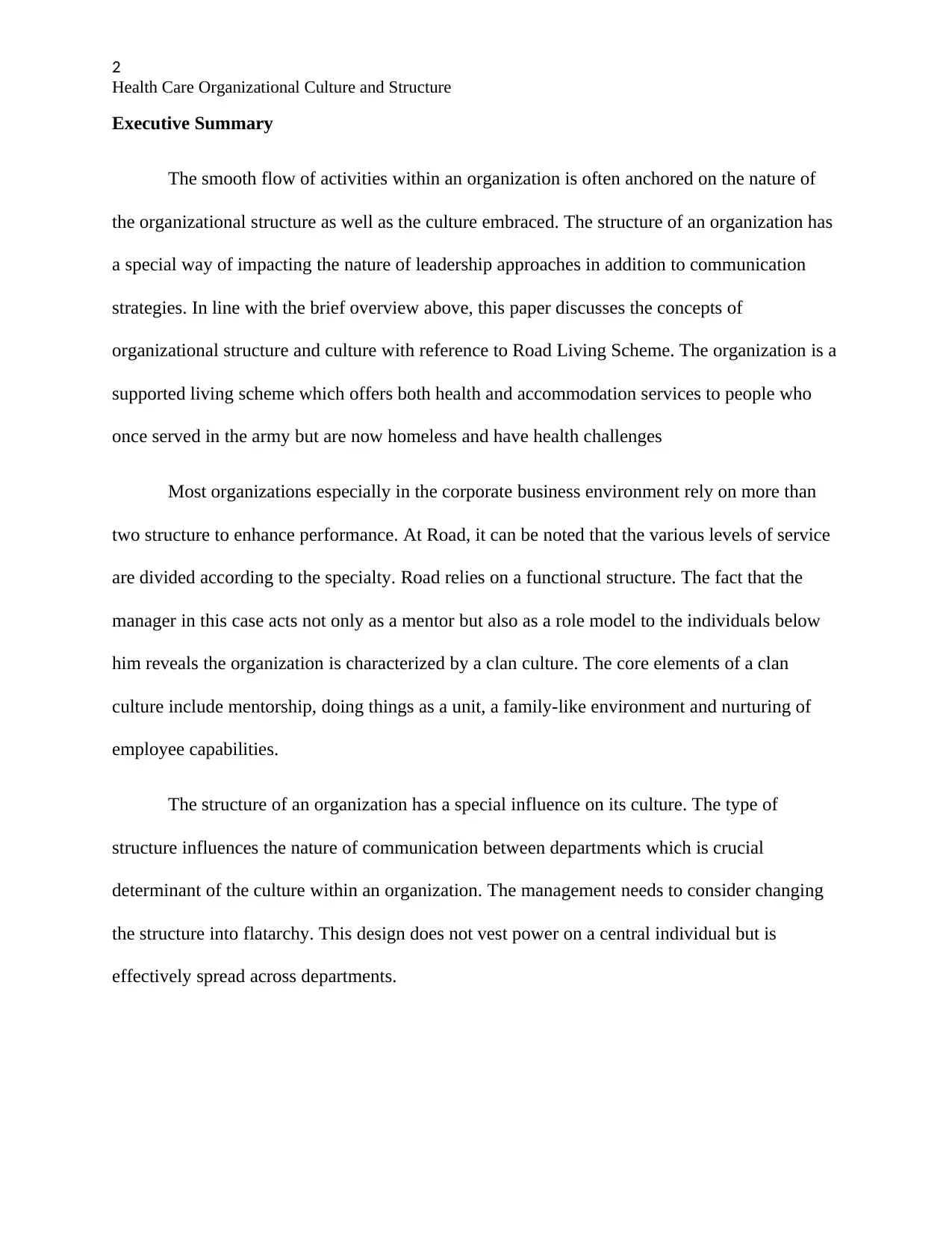
2
Health Care Organizational Culture and Structure
Executive Summary
The smooth flow of activities within an organization is often anchored on the nature of
the organizational structure as well as the culture embraced. The structure of an organization has
a special way of impacting the nature of leadership approaches in addition to communication
strategies. In line with the brief overview above, this paper discusses the concepts of
organizational structure and culture with reference to Road Living Scheme. The organization is a
supported living scheme which offers both health and accommodation services to people who
once served in the army but are now homeless and have health challenges
Most organizations especially in the corporate business environment rely on more than
two structure to enhance performance. At Road, it can be noted that the various levels of service
are divided according to the specialty. Road relies on a functional structure. The fact that the
manager in this case acts not only as a mentor but also as a role model to the individuals below
him reveals the organization is characterized by a clan culture. The core elements of a clan
culture include mentorship, doing things as a unit, a family-like environment and nurturing of
employee capabilities.
The structure of an organization has a special influence on its culture. The type of
structure influences the nature of communication between departments which is crucial
determinant of the culture within an organization. The management needs to consider changing
the structure into flatarchy. This design does not vest power on a central individual but is
effectively spread across departments.
Health Care Organizational Culture and Structure
Executive Summary
The smooth flow of activities within an organization is often anchored on the nature of
the organizational structure as well as the culture embraced. The structure of an organization has
a special way of impacting the nature of leadership approaches in addition to communication
strategies. In line with the brief overview above, this paper discusses the concepts of
organizational structure and culture with reference to Road Living Scheme. The organization is a
supported living scheme which offers both health and accommodation services to people who
once served in the army but are now homeless and have health challenges
Most organizations especially in the corporate business environment rely on more than
two structure to enhance performance. At Road, it can be noted that the various levels of service
are divided according to the specialty. Road relies on a functional structure. The fact that the
manager in this case acts not only as a mentor but also as a role model to the individuals below
him reveals the organization is characterized by a clan culture. The core elements of a clan
culture include mentorship, doing things as a unit, a family-like environment and nurturing of
employee capabilities.
The structure of an organization has a special influence on its culture. The type of
structure influences the nature of communication between departments which is crucial
determinant of the culture within an organization. The management needs to consider changing
the structure into flatarchy. This design does not vest power on a central individual but is
effectively spread across departments.
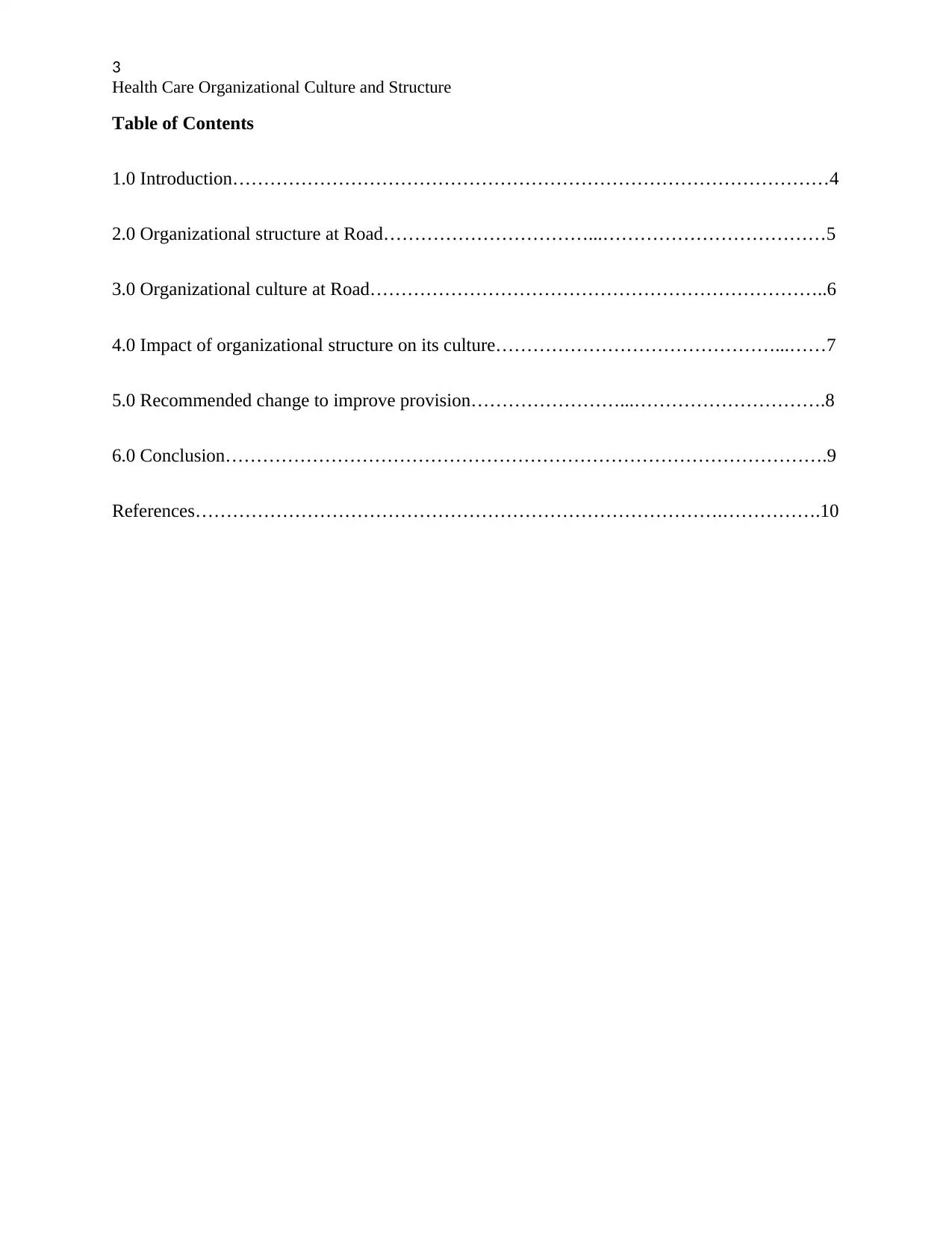
3
Health Care Organizational Culture and Structure
Table of Contents
1.0 Introduction……………………………………………………………………………………4
2.0 Organizational structure at Road……………………………...………………………………5
3.0 Organizational culture at Road………………………………………………………………..6
4.0 Impact of organizational structure on its culture………………………………………...……7
5.0 Recommended change to improve provision……………………...………………………….8
6.0 Conclusion…………………………………………………………………………………….9
References………………………………………………………………………….…………….10
Health Care Organizational Culture and Structure
Table of Contents
1.0 Introduction……………………………………………………………………………………4
2.0 Organizational structure at Road……………………………...………………………………5
3.0 Organizational culture at Road………………………………………………………………..6
4.0 Impact of organizational structure on its culture………………………………………...……7
5.0 Recommended change to improve provision……………………...………………………….8
6.0 Conclusion…………………………………………………………………………………….9
References………………………………………………………………………….…………….10
⊘ This is a preview!⊘
Do you want full access?
Subscribe today to unlock all pages.

Trusted by 1+ million students worldwide
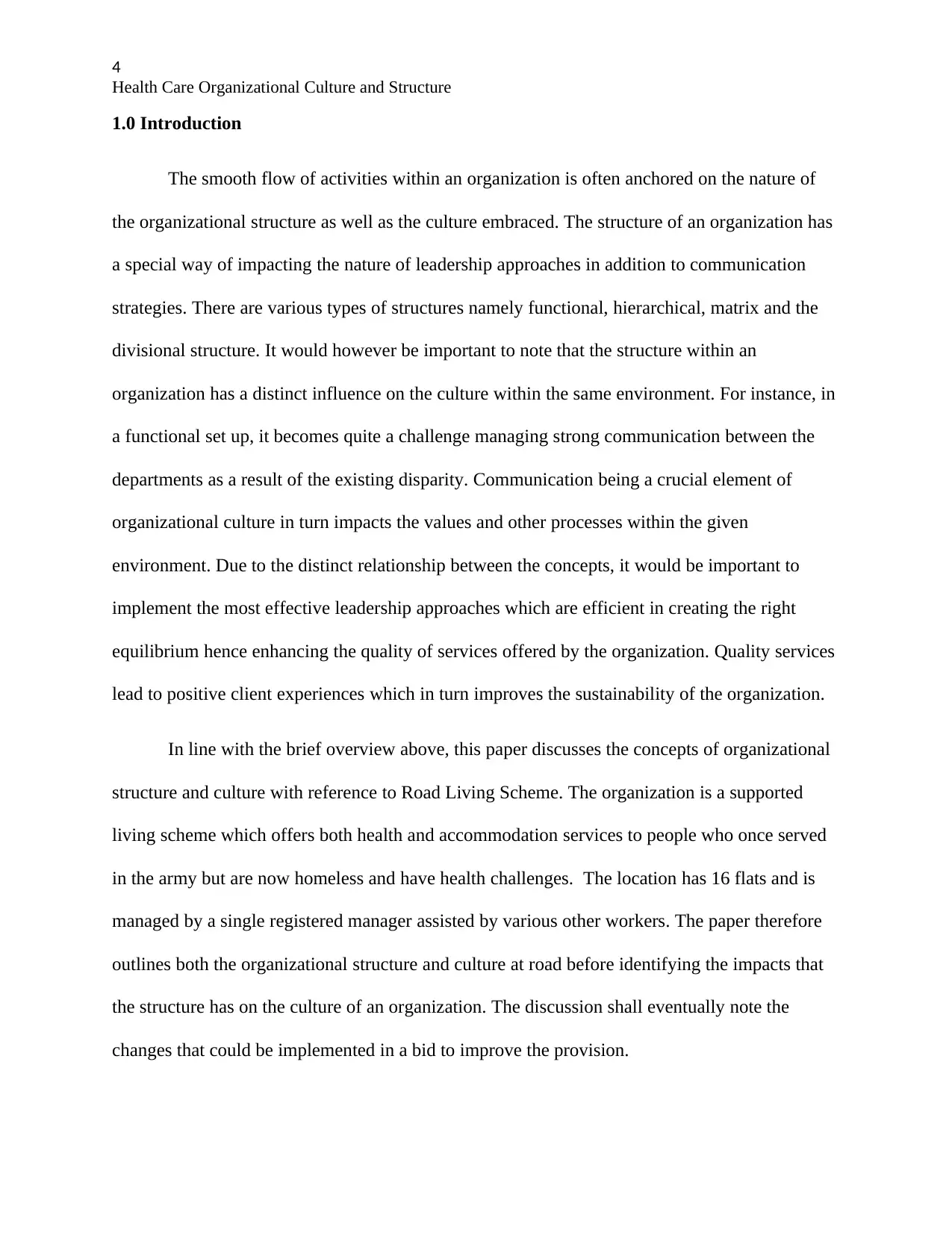
4
Health Care Organizational Culture and Structure
1.0 Introduction
The smooth flow of activities within an organization is often anchored on the nature of
the organizational structure as well as the culture embraced. The structure of an organization has
a special way of impacting the nature of leadership approaches in addition to communication
strategies. There are various types of structures namely functional, hierarchical, matrix and the
divisional structure. It would however be important to note that the structure within an
organization has a distinct influence on the culture within the same environment. For instance, in
a functional set up, it becomes quite a challenge managing strong communication between the
departments as a result of the existing disparity. Communication being a crucial element of
organizational culture in turn impacts the values and other processes within the given
environment. Due to the distinct relationship between the concepts, it would be important to
implement the most effective leadership approaches which are efficient in creating the right
equilibrium hence enhancing the quality of services offered by the organization. Quality services
lead to positive client experiences which in turn improves the sustainability of the organization.
In line with the brief overview above, this paper discusses the concepts of organizational
structure and culture with reference to Road Living Scheme. The organization is a supported
living scheme which offers both health and accommodation services to people who once served
in the army but are now homeless and have health challenges. The location has 16 flats and is
managed by a single registered manager assisted by various other workers. The paper therefore
outlines both the organizational structure and culture at road before identifying the impacts that
the structure has on the culture of an organization. The discussion shall eventually note the
changes that could be implemented in a bid to improve the provision.
Health Care Organizational Culture and Structure
1.0 Introduction
The smooth flow of activities within an organization is often anchored on the nature of
the organizational structure as well as the culture embraced. The structure of an organization has
a special way of impacting the nature of leadership approaches in addition to communication
strategies. There are various types of structures namely functional, hierarchical, matrix and the
divisional structure. It would however be important to note that the structure within an
organization has a distinct influence on the culture within the same environment. For instance, in
a functional set up, it becomes quite a challenge managing strong communication between the
departments as a result of the existing disparity. Communication being a crucial element of
organizational culture in turn impacts the values and other processes within the given
environment. Due to the distinct relationship between the concepts, it would be important to
implement the most effective leadership approaches which are efficient in creating the right
equilibrium hence enhancing the quality of services offered by the organization. Quality services
lead to positive client experiences which in turn improves the sustainability of the organization.
In line with the brief overview above, this paper discusses the concepts of organizational
structure and culture with reference to Road Living Scheme. The organization is a supported
living scheme which offers both health and accommodation services to people who once served
in the army but are now homeless and have health challenges. The location has 16 flats and is
managed by a single registered manager assisted by various other workers. The paper therefore
outlines both the organizational structure and culture at road before identifying the impacts that
the structure has on the culture of an organization. The discussion shall eventually note the
changes that could be implemented in a bid to improve the provision.
Paraphrase This Document
Need a fresh take? Get an instant paraphrase of this document with our AI Paraphraser

5
Health Care Organizational Culture and Structure
2.0 Organizational structure at Road
Most organizations especially in the corporate business environment rely on more than
two structure to enhance performance. At Road, it can be noted that the various levels of service
are divided according to the specialty of an individual. As a matter of facts, each individual
within the organization’s set up has distinct roles and the adequate implementation of these roles
is monitored and enhanced on a weekly basis. The people are dedicated to a single function
based on the area of responsibility which in turn makes accountability easy and effective. With
regard to the description above, it can be deduced that Road relies on a functional structure. The
structure is best fitting going by the size of the organization and the nature of services offered to
the clients. Additionally, a hierarchical structure is eminent at the organization. Information and
power ends with the general manager. As deduced from the case study, the other employees and
support workers within the organization are only allowed to make their decisions after consulting
the manager. He offers the direction and controls processes within the organization by
overseeing major decision making processes. The organization therefore comprises a hierarchical
and functional structure. Flatarchy as a form of culture opens up the lines of communication and
also spreads power across various points. This structure would however fail to enhance
performance in this set up due to the fact that the manager has the power which when spread to
other workers may compromise the quality of services. The noted structures therefore keep the
employees true to their responsibilities due to the level of accountability required on a weekly
basis.
Health Care Organizational Culture and Structure
2.0 Organizational structure at Road
Most organizations especially in the corporate business environment rely on more than
two structure to enhance performance. At Road, it can be noted that the various levels of service
are divided according to the specialty of an individual. As a matter of facts, each individual
within the organization’s set up has distinct roles and the adequate implementation of these roles
is monitored and enhanced on a weekly basis. The people are dedicated to a single function
based on the area of responsibility which in turn makes accountability easy and effective. With
regard to the description above, it can be deduced that Road relies on a functional structure. The
structure is best fitting going by the size of the organization and the nature of services offered to
the clients. Additionally, a hierarchical structure is eminent at the organization. Information and
power ends with the general manager. As deduced from the case study, the other employees and
support workers within the organization are only allowed to make their decisions after consulting
the manager. He offers the direction and controls processes within the organization by
overseeing major decision making processes. The organization therefore comprises a hierarchical
and functional structure. Flatarchy as a form of culture opens up the lines of communication and
also spreads power across various points. This structure would however fail to enhance
performance in this set up due to the fact that the manager has the power which when spread to
other workers may compromise the quality of services. The noted structures therefore keep the
employees true to their responsibilities due to the level of accountability required on a weekly
basis.
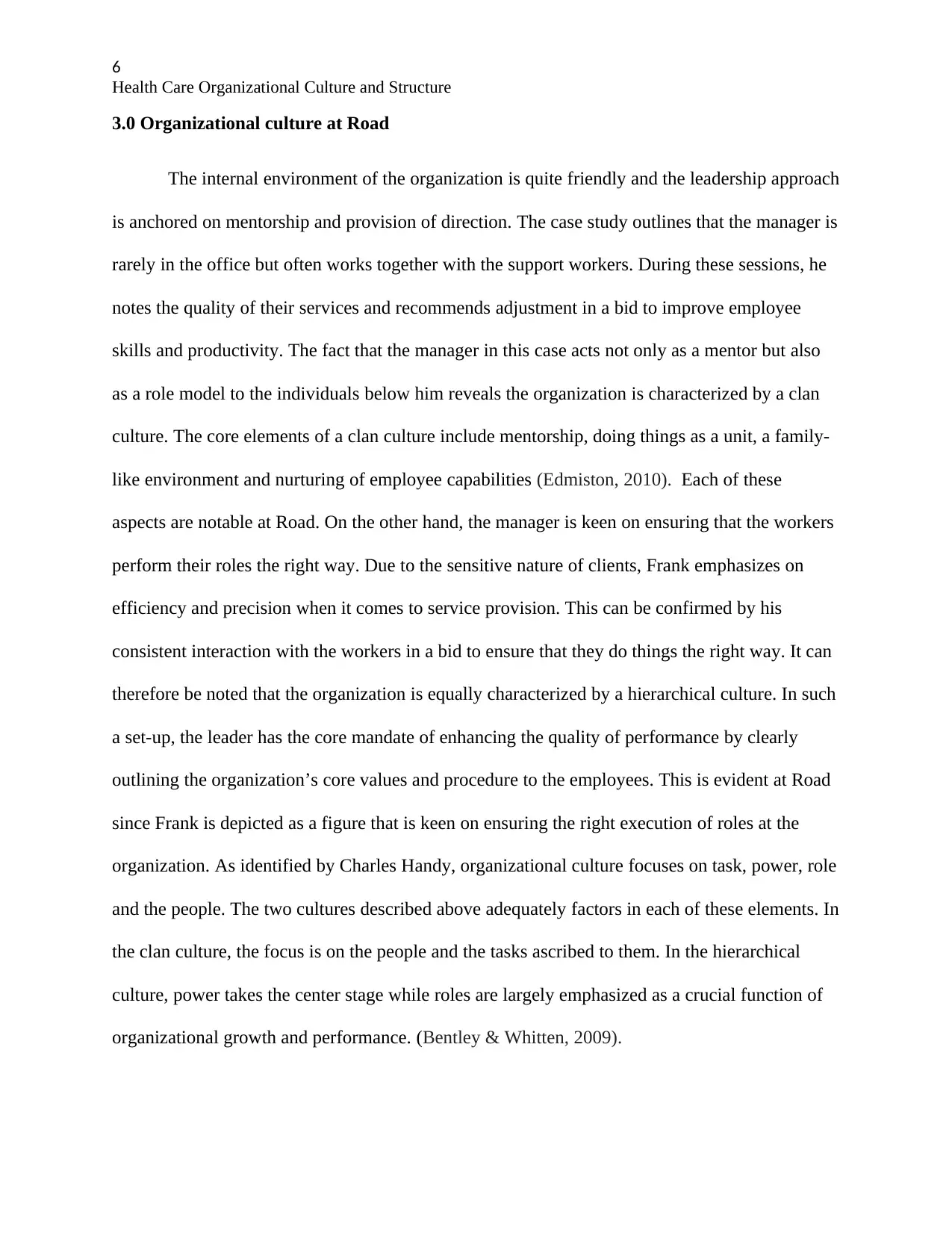
6
Health Care Organizational Culture and Structure
3.0 Organizational culture at Road
The internal environment of the organization is quite friendly and the leadership approach
is anchored on mentorship and provision of direction. The case study outlines that the manager is
rarely in the office but often works together with the support workers. During these sessions, he
notes the quality of their services and recommends adjustment in a bid to improve employee
skills and productivity. The fact that the manager in this case acts not only as a mentor but also
as a role model to the individuals below him reveals the organization is characterized by a clan
culture. The core elements of a clan culture include mentorship, doing things as a unit, a family-
like environment and nurturing of employee capabilities (Edmiston, 2010). Each of these
aspects are notable at Road. On the other hand, the manager is keen on ensuring that the workers
perform their roles the right way. Due to the sensitive nature of clients, Frank emphasizes on
efficiency and precision when it comes to service provision. This can be confirmed by his
consistent interaction with the workers in a bid to ensure that they do things the right way. It can
therefore be noted that the organization is equally characterized by a hierarchical culture. In such
a set-up, the leader has the core mandate of enhancing the quality of performance by clearly
outlining the organization’s core values and procedure to the employees. This is evident at Road
since Frank is depicted as a figure that is keen on ensuring the right execution of roles at the
organization. As identified by Charles Handy, organizational culture focuses on task, power, role
and the people. The two cultures described above adequately factors in each of these elements. In
the clan culture, the focus is on the people and the tasks ascribed to them. In the hierarchical
culture, power takes the center stage while roles are largely emphasized as a crucial function of
organizational growth and performance. (Bentley & Whitten, 2009).
Health Care Organizational Culture and Structure
3.0 Organizational culture at Road
The internal environment of the organization is quite friendly and the leadership approach
is anchored on mentorship and provision of direction. The case study outlines that the manager is
rarely in the office but often works together with the support workers. During these sessions, he
notes the quality of their services and recommends adjustment in a bid to improve employee
skills and productivity. The fact that the manager in this case acts not only as a mentor but also
as a role model to the individuals below him reveals the organization is characterized by a clan
culture. The core elements of a clan culture include mentorship, doing things as a unit, a family-
like environment and nurturing of employee capabilities (Edmiston, 2010). Each of these
aspects are notable at Road. On the other hand, the manager is keen on ensuring that the workers
perform their roles the right way. Due to the sensitive nature of clients, Frank emphasizes on
efficiency and precision when it comes to service provision. This can be confirmed by his
consistent interaction with the workers in a bid to ensure that they do things the right way. It can
therefore be noted that the organization is equally characterized by a hierarchical culture. In such
a set-up, the leader has the core mandate of enhancing the quality of performance by clearly
outlining the organization’s core values and procedure to the employees. This is evident at Road
since Frank is depicted as a figure that is keen on ensuring the right execution of roles at the
organization. As identified by Charles Handy, organizational culture focuses on task, power, role
and the people. The two cultures described above adequately factors in each of these elements. In
the clan culture, the focus is on the people and the tasks ascribed to them. In the hierarchical
culture, power takes the center stage while roles are largely emphasized as a crucial function of
organizational growth and performance. (Bentley & Whitten, 2009).
⊘ This is a preview!⊘
Do you want full access?
Subscribe today to unlock all pages.

Trusted by 1+ million students worldwide
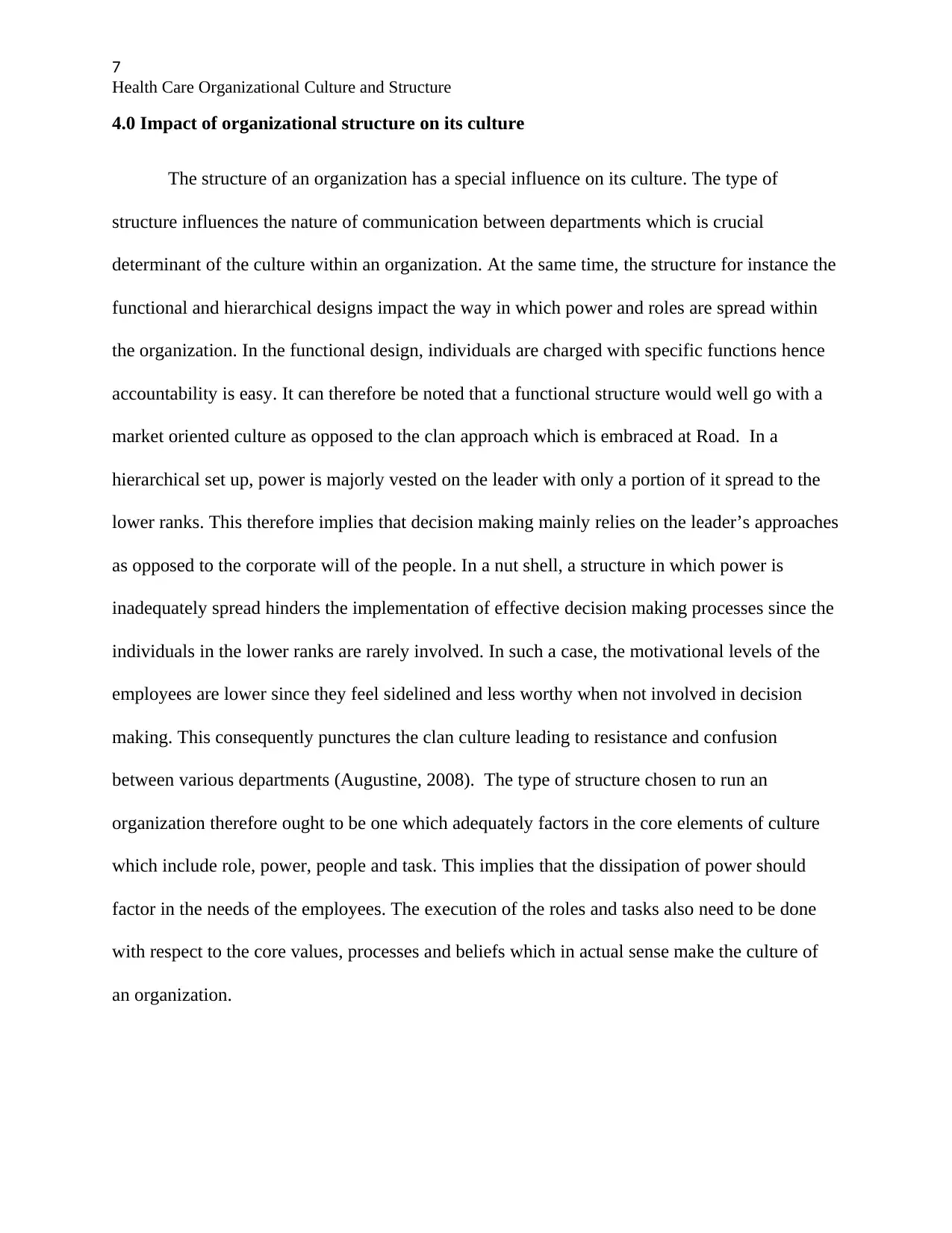
7
Health Care Organizational Culture and Structure
4.0 Impact of organizational structure on its culture
The structure of an organization has a special influence on its culture. The type of
structure influences the nature of communication between departments which is crucial
determinant of the culture within an organization. At the same time, the structure for instance the
functional and hierarchical designs impact the way in which power and roles are spread within
the organization. In the functional design, individuals are charged with specific functions hence
accountability is easy. It can therefore be noted that a functional structure would well go with a
market oriented culture as opposed to the clan approach which is embraced at Road. In a
hierarchical set up, power is majorly vested on the leader with only a portion of it spread to the
lower ranks. This therefore implies that decision making mainly relies on the leader’s approaches
as opposed to the corporate will of the people. In a nut shell, a structure in which power is
inadequately spread hinders the implementation of effective decision making processes since the
individuals in the lower ranks are rarely involved. In such a case, the motivational levels of the
employees are lower since they feel sidelined and less worthy when not involved in decision
making. This consequently punctures the clan culture leading to resistance and confusion
between various departments (Augustine, 2008). The type of structure chosen to run an
organization therefore ought to be one which adequately factors in the core elements of culture
which include role, power, people and task. This implies that the dissipation of power should
factor in the needs of the employees. The execution of the roles and tasks also need to be done
with respect to the core values, processes and beliefs which in actual sense make the culture of
an organization.
Health Care Organizational Culture and Structure
4.0 Impact of organizational structure on its culture
The structure of an organization has a special influence on its culture. The type of
structure influences the nature of communication between departments which is crucial
determinant of the culture within an organization. At the same time, the structure for instance the
functional and hierarchical designs impact the way in which power and roles are spread within
the organization. In the functional design, individuals are charged with specific functions hence
accountability is easy. It can therefore be noted that a functional structure would well go with a
market oriented culture as opposed to the clan approach which is embraced at Road. In a
hierarchical set up, power is majorly vested on the leader with only a portion of it spread to the
lower ranks. This therefore implies that decision making mainly relies on the leader’s approaches
as opposed to the corporate will of the people. In a nut shell, a structure in which power is
inadequately spread hinders the implementation of effective decision making processes since the
individuals in the lower ranks are rarely involved. In such a case, the motivational levels of the
employees are lower since they feel sidelined and less worthy when not involved in decision
making. This consequently punctures the clan culture leading to resistance and confusion
between various departments (Augustine, 2008). The type of structure chosen to run an
organization therefore ought to be one which adequately factors in the core elements of culture
which include role, power, people and task. This implies that the dissipation of power should
factor in the needs of the employees. The execution of the roles and tasks also need to be done
with respect to the core values, processes and beliefs which in actual sense make the culture of
an organization.
Paraphrase This Document
Need a fresh take? Get an instant paraphrase of this document with our AI Paraphraser
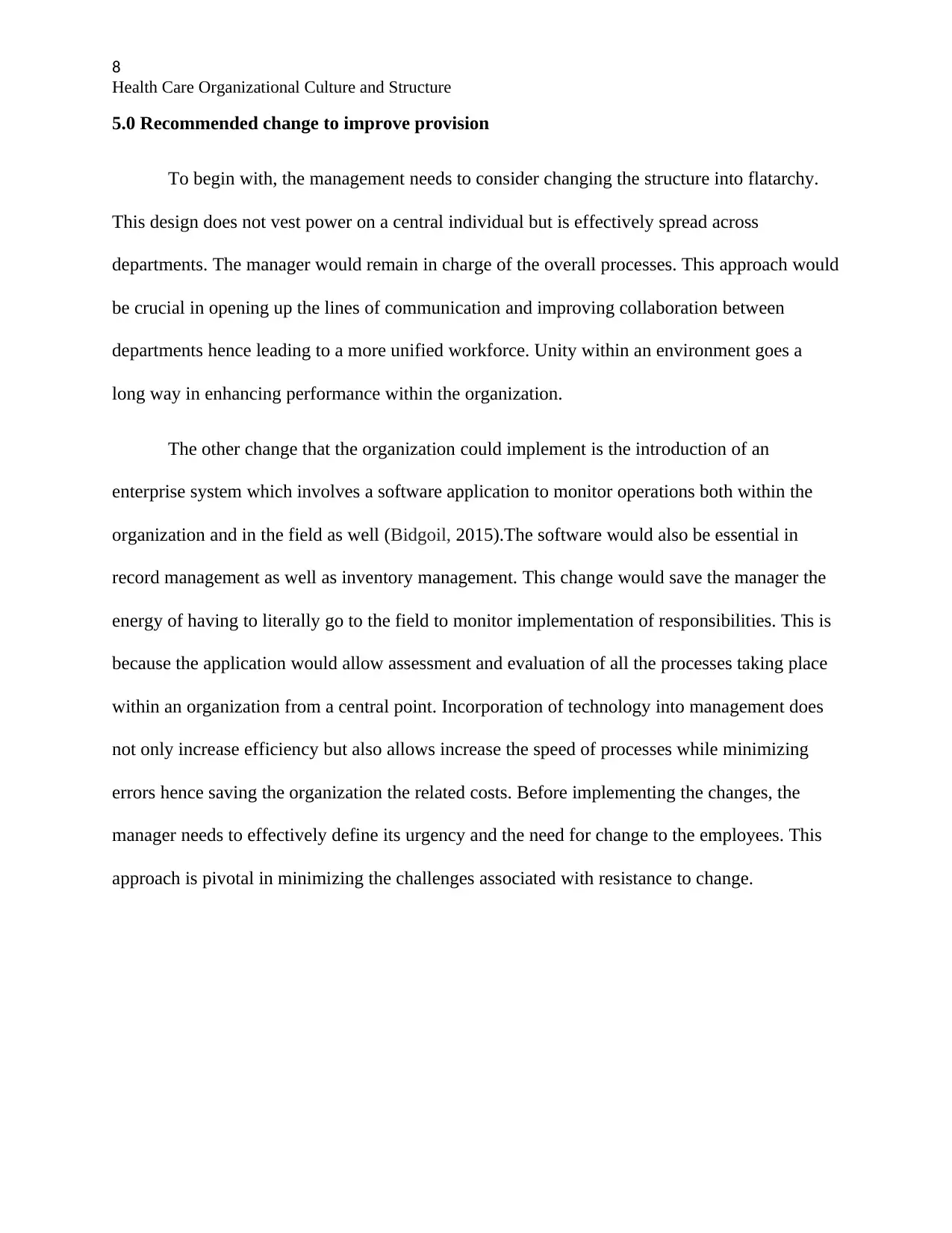
8
Health Care Organizational Culture and Structure
5.0 Recommended change to improve provision
To begin with, the management needs to consider changing the structure into flatarchy.
This design does not vest power on a central individual but is effectively spread across
departments. The manager would remain in charge of the overall processes. This approach would
be crucial in opening up the lines of communication and improving collaboration between
departments hence leading to a more unified workforce. Unity within an environment goes a
long way in enhancing performance within the organization.
The other change that the organization could implement is the introduction of an
enterprise system which involves a software application to monitor operations both within the
organization and in the field as well (Bidgoil, 2015).The software would also be essential in
record management as well as inventory management. This change would save the manager the
energy of having to literally go to the field to monitor implementation of responsibilities. This is
because the application would allow assessment and evaluation of all the processes taking place
within an organization from a central point. Incorporation of technology into management does
not only increase efficiency but also allows increase the speed of processes while minimizing
errors hence saving the organization the related costs. Before implementing the changes, the
manager needs to effectively define its urgency and the need for change to the employees. This
approach is pivotal in minimizing the challenges associated with resistance to change.
Health Care Organizational Culture and Structure
5.0 Recommended change to improve provision
To begin with, the management needs to consider changing the structure into flatarchy.
This design does not vest power on a central individual but is effectively spread across
departments. The manager would remain in charge of the overall processes. This approach would
be crucial in opening up the lines of communication and improving collaboration between
departments hence leading to a more unified workforce. Unity within an environment goes a
long way in enhancing performance within the organization.
The other change that the organization could implement is the introduction of an
enterprise system which involves a software application to monitor operations both within the
organization and in the field as well (Bidgoil, 2015).The software would also be essential in
record management as well as inventory management. This change would save the manager the
energy of having to literally go to the field to monitor implementation of responsibilities. This is
because the application would allow assessment and evaluation of all the processes taking place
within an organization from a central point. Incorporation of technology into management does
not only increase efficiency but also allows increase the speed of processes while minimizing
errors hence saving the organization the related costs. Before implementing the changes, the
manager needs to effectively define its urgency and the need for change to the employees. This
approach is pivotal in minimizing the challenges associated with resistance to change.

9
Health Care Organizational Culture and Structure
6.0 Conclusion
The performance and growth of an organization largely depends on the structure and
culture. Effective structures enhance the efficient execution of roles and responsibilities. At the
same time, a structure which comprises more channels of communication improves the flow of
processes and in turn leads to the establishment of a healthy culture. The discussion reveals that
organizational structures have direct impacts on the culture. This consequently calls for the need
of the most appropriate leadership approaches which create the right environment for
performance and improvement. At Road, the manager needs to apply the right communication
approaches in addition to exclusive decision making skills to ensure that while the tasks are
completed and roles accomplished, the needs of the people are met with equal measure
(Chesbrough, 2010).
Health Care Organizational Culture and Structure
6.0 Conclusion
The performance and growth of an organization largely depends on the structure and
culture. Effective structures enhance the efficient execution of roles and responsibilities. At the
same time, a structure which comprises more channels of communication improves the flow of
processes and in turn leads to the establishment of a healthy culture. The discussion reveals that
organizational structures have direct impacts on the culture. This consequently calls for the need
of the most appropriate leadership approaches which create the right environment for
performance and improvement. At Road, the manager needs to apply the right communication
approaches in addition to exclusive decision making skills to ensure that while the tasks are
completed and roles accomplished, the needs of the people are met with equal measure
(Chesbrough, 2010).
⊘ This is a preview!⊘
Do you want full access?
Subscribe today to unlock all pages.

Trusted by 1+ million students worldwide
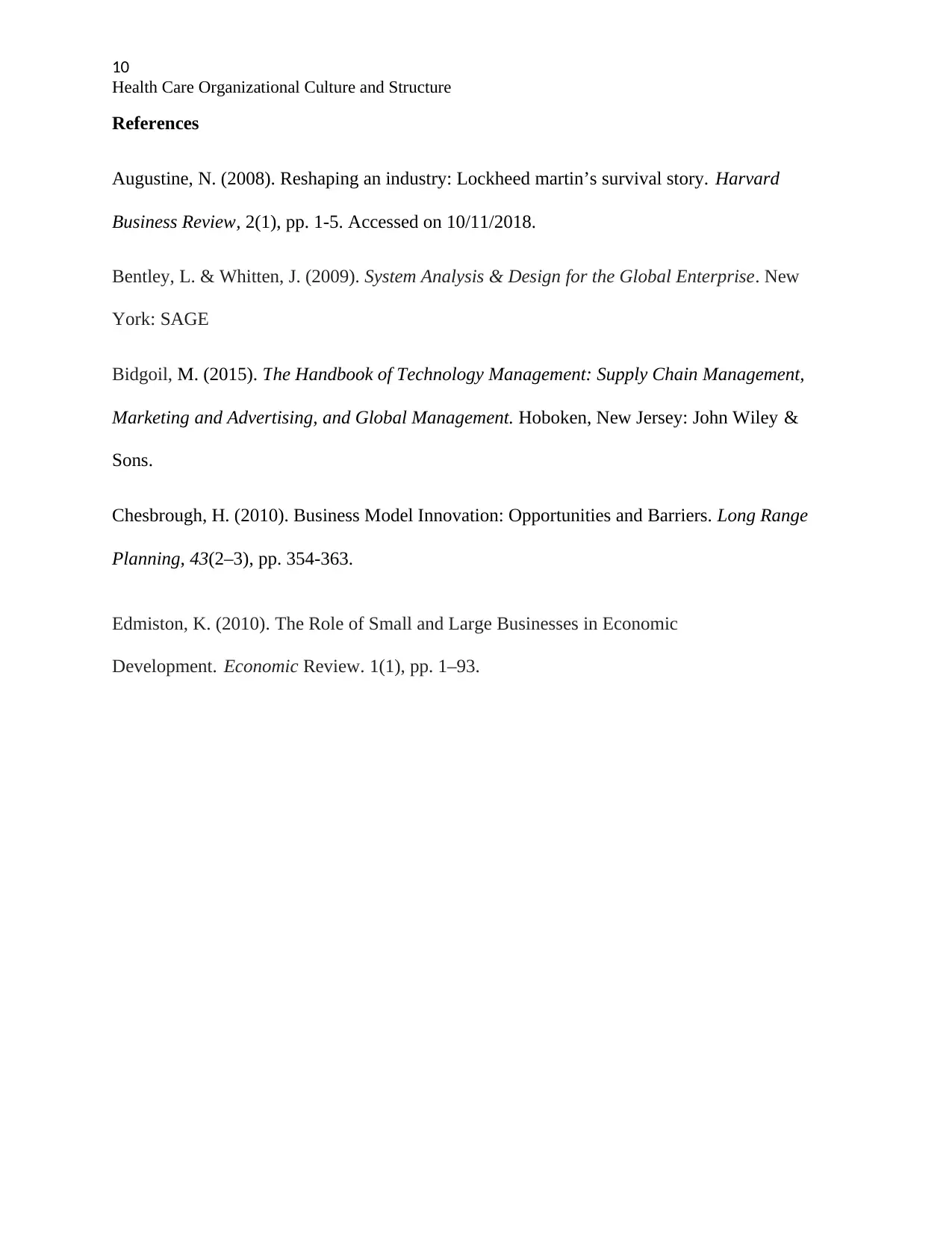
10
Health Care Organizational Culture and Structure
References
Augustine, N. (2008). Reshaping an industry: Lockheed martin’s survival story. Harvard
Business Review, 2(1), pp. 1-5. Accessed on 10/11/2018.
Bentley, L. & Whitten, J. (2009). System Analysis & Design for the Global Enterprise. New
York: SAGE
Bidgoil, M. (2015). The Handbook of Technology Management: Supply Chain Management,
Marketing and Advertising, and Global Management. Hoboken, New Jersey: John Wiley &
Sons.
Chesbrough, H. (2010). Business Model Innovation: Opportunities and Barriers. Long Range
Planning, 43(2–3), pp. 354-363.
Edmiston, K. (2010). The Role of Small and Large Businesses in Economic
Development. Economic Review. 1(1), pp. 1–93.
Health Care Organizational Culture and Structure
References
Augustine, N. (2008). Reshaping an industry: Lockheed martin’s survival story. Harvard
Business Review, 2(1), pp. 1-5. Accessed on 10/11/2018.
Bentley, L. & Whitten, J. (2009). System Analysis & Design for the Global Enterprise. New
York: SAGE
Bidgoil, M. (2015). The Handbook of Technology Management: Supply Chain Management,
Marketing and Advertising, and Global Management. Hoboken, New Jersey: John Wiley &
Sons.
Chesbrough, H. (2010). Business Model Innovation: Opportunities and Barriers. Long Range
Planning, 43(2–3), pp. 354-363.
Edmiston, K. (2010). The Role of Small and Large Businesses in Economic
Development. Economic Review. 1(1), pp. 1–93.
Paraphrase This Document
Need a fresh take? Get an instant paraphrase of this document with our AI Paraphraser
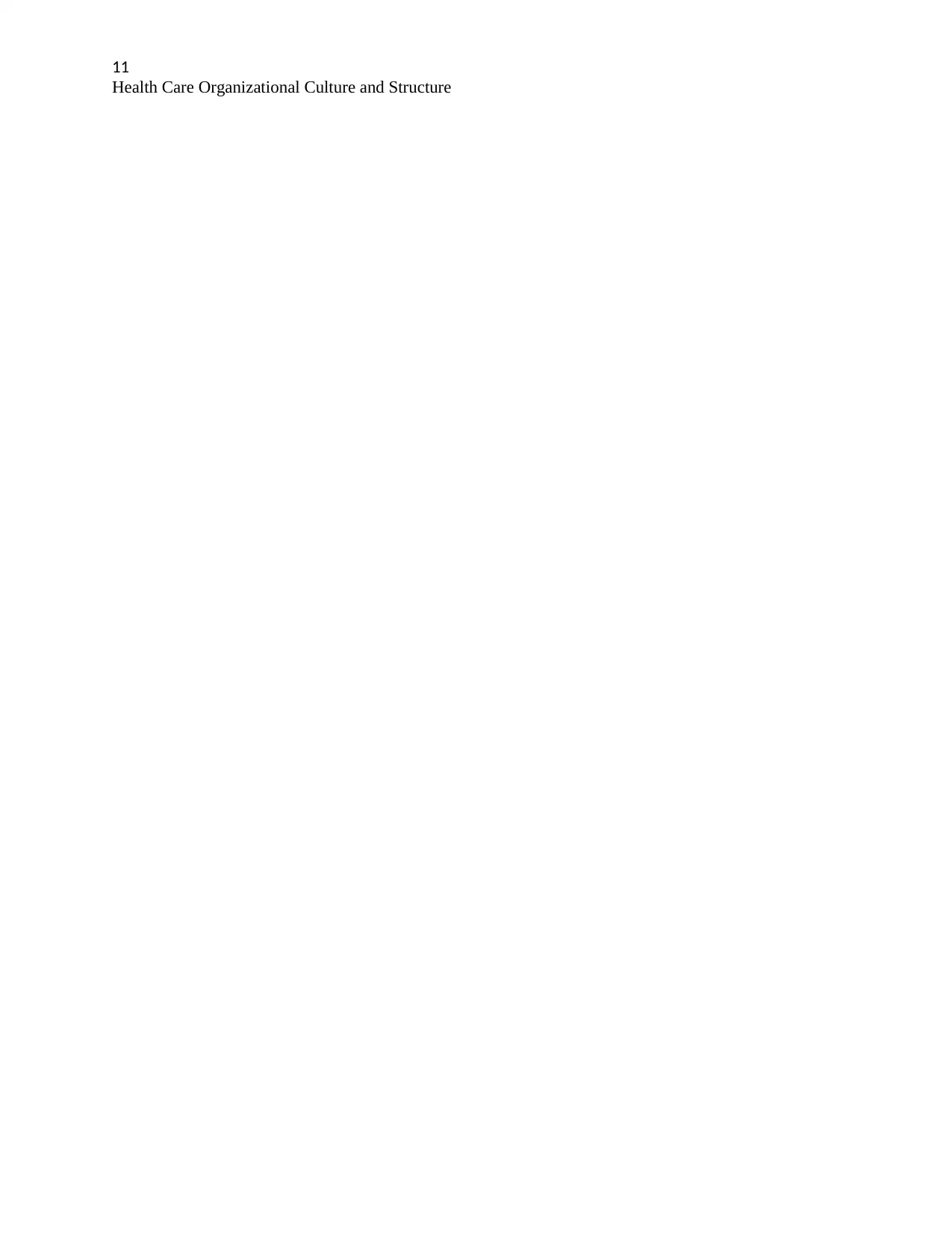
11
Health Care Organizational Culture and Structure
Health Care Organizational Culture and Structure
1 out of 11
Related Documents
Your All-in-One AI-Powered Toolkit for Academic Success.
+13062052269
info@desklib.com
Available 24*7 on WhatsApp / Email
![[object Object]](/_next/static/media/star-bottom.7253800d.svg)
Unlock your academic potential
Copyright © 2020–2025 A2Z Services. All Rights Reserved. Developed and managed by ZUCOL.




